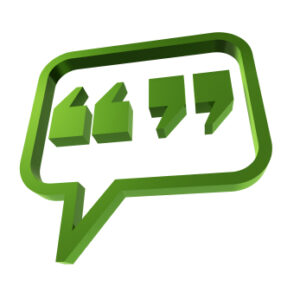How to Punctuate Quotes in Your Press Releases
 Mastering the art of quote punctuation can transform mediocre press release pickup into widespread, effective coverage. Why? Because, while seemingly minor, these grammatical details signal credibility to journalists and readers alike.
Mastering the art of quote punctuation can transform mediocre press release pickup into widespread, effective coverage. Why? Because, while seemingly minor, these grammatical details signal credibility to journalists and readers alike.
This guide outlines the essential rules for properly punctuating quotes in your press releases, ensuring your company’s messages appear as authoritative as the executives you’re quoting.
Quotes in Press Releases
Now with that in mind, it’s important to note that the quotes you include are perhaps the most important part of your press release. Why? Well, not only do they offer a more human side to your release, but they also lend a bit of credibility. Rather than the reader hearing about some company that they may know nothing about from a third party, they get it from the horse’s mouth, so to speak, when you include valuable quotes from the people directly involved — the primary source.
Now, all that being said, you can imagine how important it is to get that quote right. And that means you have to know the rules to punctuating quotes in your release. Otherwise, someone might throw it in the trash before they finish it. Sure, that may sound extreme, but it will at least devalue their opinion of you as a writer, and therefore as a credible source.
Punctuation Rules for Quotes
Okay, so now that I’ve shown you how important it is to properly punctuate your quotes, let me take you through some of the most important rules to help you do just that:
Periods in Quotes
Put Commas and Periods Inside the Quotation Marks.
Say you have the following quote:
“Our company is looking to reach a larger audience than ever before,” John Doe said.
Notice, there has to be a comma inside the quotation marks to separate what John Doe is actually saying from the tagline, the part that lets the reader know who is saying the quote. A common mistake (that makes writers look completely amateur) would be to write:
“Our company is looking to reach a larger audience than ever before”, John Doe said.
And interesting to note, when typing this, Word’s grammar checker did NOT catch that error. Nor did it catch it when I tried simply leaving the comma out altogether. So don’t rely on Word’s grammar checker!
Typically, If a Quote Ends the Sentence, Then the Final Punctuation (Periods, Question Marks, or Exclamation Points) Go Inside the Quotation Marks.
Take this sentence:
Susie Q. said, “We weren’t sure what to do next, but then the answer hit us.”
Since the quote ends with a period, the period goes inside the quote marks.
Or this one:
“Our company is looking to reach a larger audience than ever before.” John Doe said, “our expansion into China is a vital part of this effort.”
No period is needed after the quote. The period inside the quote signifies the end of the quote, as well as the end of the actual sentence. The only time this may differ is if the sentence itself, but not the quote, is a question. Example:
Did Susie Q. say, “The answer hit us”?
However, you aren’t typically asking questions in a press release, so you probably won’t run across this one.
Capitalize the First Word of Your Quote.
If the Tagline Comes First, the Comma Comes Before the Quotation Marks.
In the example above, notice that the comma came directly after the word “said,” not after the quotation marks. It’s also important to note that a comma is necessary there, even though many people tend to omit it.
More Punctuation Rules for Press Release Quotations
-
Colons and semicolons always go outside the quotation marks
Example: The CEO described the launch as “groundbreaking”; she later expanded on this statement.
-
Question marks and exclamation points go inside if they’re part of the quote, outside if they’re part of your sentence
Example: Did the CEO really call the product “revolutionary”? Example: The CEO asked, “When will the product launch?”
-
Attribution generally follows the quote, separated by a comma inside the quotation marks
Example: “Our company is committed to sustainability,” said Marketing Director John Davis.
-
Block quotes (typically quotes longer than 40 words) don’t use quotation marks
But are indented and sometimes italicized
-
Quotes within quotes use single quotation marks
Example: “When the customer said ‘this changed everything,’ we knew we had succeeded,” explained the product manager.
-
Partial quotes follow the same punctuation rules
Example: The CEO described the initiative as “the most significant advancement in years.”
Are there any other quotation punctuation rules you feel we should discuss? Tell us about them!
This article is written by Mickie Kennedy, founder of eReleases (https://www.ereleases.com), the online leader in affordable press release distribution. Download your free copy of the Beginner’s Guide to Writing Powerful Press Releases here: https://www.ereleases.com/free-offer/beginners-guide-writing-powerful-press-releases/
